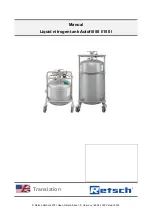
Safety and occupational health instructions
11
This list is not complete.
2.3.4 General conduct in the case of an accident
In the case of an accident from oxygen deficiency the following regulations should be observed.
• Secure the surrounding area to avoid any subsequent accidents.
• Act quickly.
• The rescuers must take measures to protect themselves (respiratory protection device).
• Move the injured persons from the hazardous area.
• Observe the company instructions for emergencies.
• Ventilate the rooms affected sufficiently.
• Investigate the cause of the accident.
This list is not complete.
2.4 Safety instructions on the handling of liquid nitrogen (Cryogenic burns)
Liquid nitrogen is very cold (-196 °C).
The surfaces of vessels that were in contact in liquid nitrogen (in particular during the filling
process) may cause skin burns on contact.
2.4.1 Dangers
Cryogenic liquids may:
– bring about burns to the human body
– make specific materials (metal and plastic) that are not suitable for low temperatures brittle
– generate strong misting depending on atmospheric humidity
2.4.2 Causes
There are two types of cryogenic burns:
2.4.2.1
Burns through splashes
When handling samples and in general when handling liquid nitrogen, personnel must protect
themselves from splashes. They can cause cryogenic burns with serious consequential
damage, in particular to eyes and face.
2.4.2.2
Burns through contact
Contact of the skin with cold material causes frostbite or cryogenic burns.
The interior of vessels or the samples may never be touched or held with bare hands.
2.4.3 Recommendations
In order to prevent the danger of burning the following points must be observed:
• Never bring cryogenic liquids in contact with the skin.
•
Never touch the cold non-isolated or iced walls of a vessel.
•
Wear personal protective equipment (suitable gloves, goggles or face
protection and safety shoes).
• Keep the vessel upright.
•
Use suitable material (e.g. metal hose or PTFE hose) to refill.
• Train personnel.
This list is not complete.











































